April 16, 2010
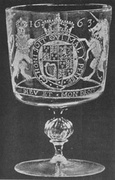
This article describes royal commemorative glass, which became popular to celebrate the return and marriage of Charles II in the 17th century and continued through the 18th century depicting other important historical figures. It originally appeared in the September 1943 issue of American Collector magazine, a publication which ran from 1933-1948 and served antiques collectors and dealers.
“All the discourse now-a-day,” wrote Samuel Pepys in the spring of 1660, “is that the King will come again; and for … (continue reading)

This article describes furniture with a functional design – that is, furniture with multiple uses, such as a settee that doubles as a table or a library chair that unfolds, revealing a step-ladder to be used to reach a book on a high shelf. It originally appeared in the February 1943 issue of American Collector magazine, a publication which ran from 1933-1948 and served antiques collectors and dealers.
“Functional design.” For better than a decade this phrase … (continue reading)

This article discusses porcelain items imported during the 18th and 19th centuries, noting the evolution in American taste from French to English china and the items used by U.S. presidents. It originally appeared in the February 1943 issue of American Collector magazine, a publication which ran from 1933-1948 and served antiques collectors and dealers.
For the most part our colonial ancestors were accustomed to a simple and even frugal mode of life. But here and there along the … (continue reading)

This article discusses the Forestville Manufacturing Company, noting the company’s origins, the clocks that they made, and the labels that they used to mark their products. It originally appeared in the September 1947 issue of American Collector magazine, a publication which ran from 1933-1948 and served antiques collectors and dealers.
The name and label of the Forestville Manufacturing Company marks some fine and intelligently made Connecticut shelf clocks. This company was a prolific source of clock making from … (continue reading)
September 24, 2009
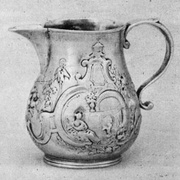
This article discusses household silver in the first half of the 18th century, noting its foreign influences in style (especially French) and silversmith Paul Lamerie, of whom the most information has been preserved over time. It originally appeared in the January 1946 issue of American Collector magazine, a publication which ran from 1933-1948 and served antique collectors and dealers.
Possession of silver articles has always been considered as a step up on the social ladder; something … (continue reading)
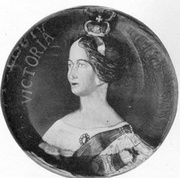
This article talks about paperweights that were created using pinchbeck, or fake gold, noting their production processes and the materials used, and describing some specific examples. It originally appeared in the November 1945 issue of American Collector magazine, a publication which ran from 1933-1948 and served antique collectors and dealers.
An insurance broker picks up his telephone, and recognizes the voice of one of his clients, a woman who is a collector of old glass paperweights. … (continue reading)
August 1, 2009

This article discusses how the author became interested in china, describing auction procedures, the images represented on china items, and specific items in the author’s collection. It originally appeared in the August 1947 issue of American Collector magazine, a publication which ran from 1933-1948 and served antique collectors and dealers.
I have long since become familiar with the query: “How did you start collecting historical Staffordshire china?” I was casually introduced to the subject 27 years … (continue reading)

This article discusses popular clockmakers in New York in the 19th century, describing their craft and the types of clocks they made. It originally appeared in the May 1938 issue of American Collector magazine, a publication which ran from 1933-1948 and served antique collectors and dealers.
Before the Revolutionary War, New York consisted chiefly of the Hudson River Valley. The Mohawk Valley and the rest of Central and Western New York remained in the possession of … (continue reading)
May 30, 2009
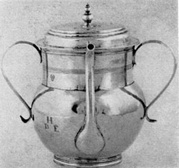
This article focuses on small silver items that were popular in the 18th century, from strainers to tobacco boxes to jewelry, describing the uses for each, and it notes how often silver items were stolen or lost. It originally appeared as a two-part series in the March and April 1942 issues of American Collector magazine, a publication which ran from 1933-1948 and served antique collectors and dealers.
Part I:
“Stole at Flatbush on Long-Island, One Silver Tankerd, a … (continue reading)
May 10, 2009
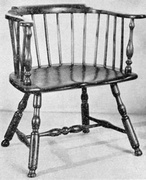
This article describes Windsor chairs, noting their evolution, their different styles, their popularity in America (from shops that made them to farmers who created homemade versions), and some prominent chairmakers. It originally appeared in the September 1945 issue of American Collector magazine, a publication which ran from 1933-1948 and served antique collectors and dealers.
If the Windsor chair had been invented in the 20th Century it would have been classified as functional furniture and rightly so. Perfectly … (continue reading)

This article discusses 18th-century American military buttons, noting that information on these buttons is scarce and describing the different uniforms and military buttons that were worn. It originally appeared in the January 1946 issue of American Collector magazine, a publication which ran from 1933-1948 and served antique collectors and dealers.
American military buttons of the eighteenth century are comparatively rare, and the two recently acquired New York State Militia buttons illustrated are, for me, a noteworthy … (continue reading)
April 25, 2009
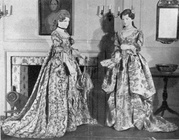
This article describes the dresses that were worn to a ball by two prominent women in 1780. It originally appeared in the October 1948 issue of American Collector magazine, a publication which ran from 1933-1948 and served antique collectors and dealers.
When Mrs. Gabriel Ludlow and her sister, Mrs. Abraham Walton, entered the ballroom about 1780 they must have created quite a sensation in the sophisticated little town of New York. Their brocaded silk dresses, entirely … (continue reading)
April 22, 2009

This article discusses the two conflicting opinions about Thomas Chippendale (some say he is not worthy of the fame he received, while others say he was a master of furniture design), also noting the stretch of his influence and the differences between Chippendale furniture created in the U.S. and in England. It originally appeared in the June 1941 issue of American Collector magazine, a publication which ran from 1933-1948 and served antiques collectors and dealers.
For over … (continue reading)
April 16, 2009
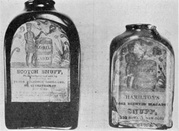
This article discusses the packaging used for early American consumer products, describing some examples and noting their intrigue. It originally appeared in the December 1942 issue of American Collector magazine, a publication which ran from 1933-1948 and served antique collectors and dealers.
One of America’s famed industrial designers sat at his quite modern desk (which he thinks was designed in 1936 but which was already old stuff in 1836) and, with his nose well in the air, … (continue reading)

This article describes the 19th-century glass slippers and boots pictured, noting which are the rarest and most desirable for collectors. It originally appeared in the June 1942 issue of American Collector magazine, a publication which ran from 1933-1948 and served antique collectors and dealers.
In recent years collectors of antiques, particularly American, have displayed an ever-increasing tendency toward specialization. This may be due to the fact that our collecting tempo has steadily increased. So much so that … (continue reading)















 Geeking Out Over the Bloody Legacy of VHS
Geeking Out Over the Bloody Legacy of VHS Lady Gaga, Innovator or Copycat? We Dissect “Born This Way”
Lady Gaga, Innovator or Copycat? We Dissect “Born This Way” Amazing! Spectacular! Step Right Up and Get a Piece of the Greatest Shows on Earth
Amazing! Spectacular! Step Right Up and Get a Piece of the Greatest Shows on Earth Kaboom! 10 Facts About Firecrackers That Will Blow You Away
Kaboom! 10 Facts About Firecrackers That Will Blow You Away Modern Metallics: Monet Costume Jewelry
Modern Metallics: Monet Costume Jewelry Mari Tepper: Laying it on the Line
Mari Tepper: Laying it on the Line Nice Ice: Valerie Hammond on the Genteel Charm of Vintage Canadian Costume Jewelry
Nice Ice: Valerie Hammond on the Genteel Charm of Vintage Canadian Costume Jewelry How Jim Heimann Got Crazy for California Architecture
How Jim Heimann Got Crazy for California Architecture Modernist Man: Jock Peters May Be the Most Influential Architect You've Never Heard Of
Modernist Man: Jock Peters May Be the Most Influential Architect You've Never Heard Of Meet Cute: Were Kokeshi Dolls the Models for Hello Kitty, Pokemon, and Be@rbrick?
Meet Cute: Were Kokeshi Dolls the Models for Hello Kitty, Pokemon, and Be@rbrick? When the King of Comedy Posters Set His Surreal Sights on the World of Rock 'n' Roll
When the King of Comedy Posters Set His Surreal Sights on the World of Rock 'n' Roll How One Artist Makes New Art From Old Coloring Books and Found Photos
How One Artist Makes New Art From Old Coloring Books and Found Photos Say Cheese! How Bad Photography Has Changed Our Definition of Good Pictures
Say Cheese! How Bad Photography Has Changed Our Definition of Good Pictures Middle Earthenware: One Family's Quest to Reclaim Its Place in British Pottery History
Middle Earthenware: One Family's Quest to Reclaim Its Place in British Pottery History Fancy Fowl: How an Evil Sea Captain and a Beloved Queen Made the World Crave KFC
Fancy Fowl: How an Evil Sea Captain and a Beloved Queen Made the World Crave KFC